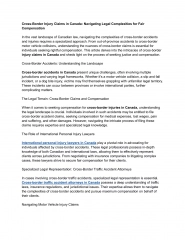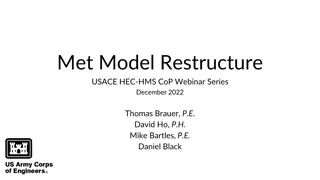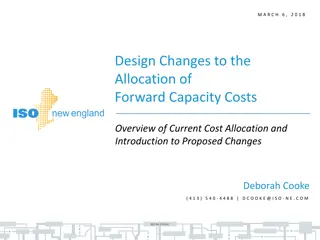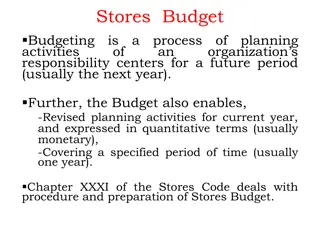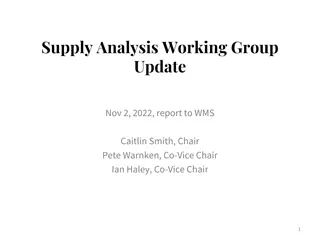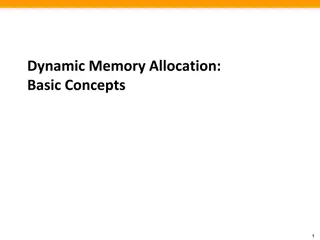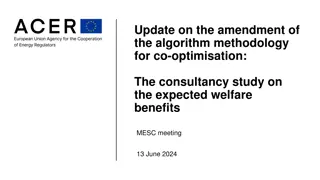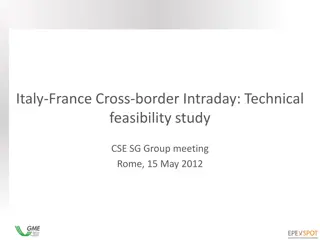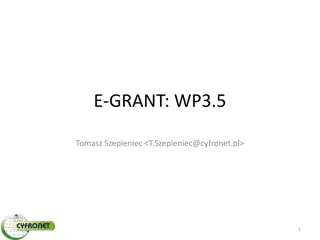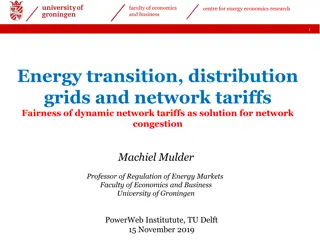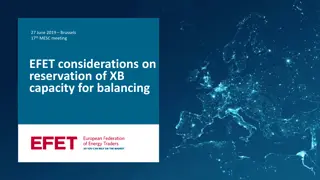Co-optimisation Process for Cross-Zonal Capacity Allocation
The meeting discussed the co-optimisation process for cross-zonal capacity allocation outlined in Article 40. It includes developing a methodology for the allocation process, feedback from public consultation, and a timeline for implementation. Stakeholders raised concerns regarding co-optimization principles and the linking of day-ahead energy and balancing capacity bids. The implementation timeline involves TSOs submitting impact assessments, algorithm requirements, and proposals to NEMOs and ACER. Approval is expected by December 2019.
Uploaded on Oct 10, 2024 | 0 Views
Download Presentation

Please find below an Image/Link to download the presentation.
The content on the website is provided AS IS for your information and personal use only. It may not be sold, licensed, or shared on other websites without obtaining consent from the author.If you encounter any issues during the download, it is possible that the publisher has removed the file from their server.
You are allowed to download the files provided on this website for personal or commercial use, subject to the condition that they are used lawfully. All files are the property of their respective owners.
The content on the website is provided AS IS for your information and personal use only. It may not be sold, licensed, or shared on other websites without obtaining consent from the author.
E N D
Presentation Transcript
TSOs-NEMOs-RAs/ACER meeting on co-optimisation process EBGL Art. 40 PT CZCA 13.11.2019 CEER 1
Agenda 1. 2. 3. Recap on Article 40: Co-optimisation process General feedback from public consultation Timeline for implementation Appendix Linking of bids
1 Recap on Article 40: Co-optimisation process 1. By two years after entry into force of this Regulation, all TSOs shall develop a proposal for a methodology for a co-optimised allocation process of cross-zonal capacity for the exchange of balancing capacity or sharing of reserves. This methodology shall apply for the exchange of balancing capacity or sharing of reserves with a contracting period of not more than one day and where the contracting is done not more than one day in advance of the provision of the balancing capacity. The methodology shall include: (a) the notification process for the use of the co-optimised allocation process; (b) a detailed description of how cross-zonal capacity shall be allocated to bids for the exchange of energy and bids for the exchange of balancing capacity or sharing of reserves in a single optimisation process performed for both implicit and explicit auctions; (c) a detailed description of the pricing method, the firmness regime and the sharing of congestion income for the cross-zonal capacity that has been allocated to bids for the exchange of balancing capacity or sharing of reserves via the co-optimised allocation process; (d) the process to define the maximum volume of allocated cross-zonal capacity for the exchange of balancing capacity or sharing of reserves. 3
2 General feedback from public consultation The main concern of the stakeholders were: Some stakeholders don t agree with the principle of co-optimization as proposed by the EBGL Enable the linking of the day-ahead energy and balancing capacity bids Clarify the process: capacity contracting period and how the CZC of balancing capacity is released to DA market and ID market(s) Elaborate on positive, negative and partial validation BCCs should notify all-TSOs and all-Stakeholders Timing: By when should balancing capacity bids be submitted and if the notification period (<1h) could be reduced Any additional limitations, if they are established (TSOs/NRAs or both) they should be defined, disclosed and justified Clarify seller , consumer , consumer and buyer terms Difference between contractduration and validityperiod 4
3 Timeline for implementation TSOs submit the Implementation Impact Assessment endorsed by NEMOs D+ 12M (TBD) D + 6M TSOs submit the co- optimisation algorithm requirements to NEMOs and ACER TSOs submit the proposal to ACER NEMOs implement the co-optimisation requirements ACER approved the proposal 18 Dec 19 (D) D + 24M (**) TSOs prepare the algorithm requirements (*) (*) ACER/RAs ensures that NEMOs are bound to implement CO CZCA (EC) (**) Conditionate to (*) 5
3 Implementation Impact Analysis TSOs are currently drafting the implementation timeline Article and propose to include in the implementation an implementation impact analysis between the TSOs, NEMOs and ACER. The implementation impact analysis might include study on the following topics: The implementation impact assessment shall include: a. Governance of the cross-zonal capacity allocation optimisation function; b. Technical feasibility of the implementation of the cross-zonal capacity allocation optimisation function; c. Level of linkage between standard balancing capacity products bids in time and between products and between standard balancing capacity bids and day-ahead market bids; d. The reasoning for the two-steps approach e. Costs estimation, categorisation and sharing The implementation impact analysis should be made transparent and after the approval could be published on the ENTSO-E website. 6
Linking of the bids Three options are possible: Soft linking of bids where not used balancing capacity bids could be used for DAM (different volume and price possible of course) Full linking of bids where market parties can submit combined bids with full complexity to one nominated market operator for both markets No linking of bids allowed (current proposal), clearly separated markets and processes 7
Co-optimisation Process without linking 5 step approach Balancing process Trading process 0) CZC to be used for SDAC is calculated. calculation and publication of CZC 1) Pure BC bids (upward/downward) and pure DA energy offers are submitted to TSOs and NEMOs, respectively. D-1 12:00 2) The TSOs convert the BC bids in cross-border seller orders and convert their TSO demand into buyer order books. NEMOs convert the DAM bids into supply and demand order books, to prepare for the SDAC. This is officially called the pre-coupling stage of SDAC. Pure DA Energy bids (to NEMOs) Pure Balancing capacity bids by BSPs to TSOs 1) Bids submission Bid-preparation by TSOs Bids are converted into supply and demand orders for the reserve exchange market + BC demand (TSOs) Bid-preparation by NEMOs Bids are converted into supply and demand orders for the energy market 2) Bid-preparation 3) The SDAC is run taking into account the value of CZC for balancing capacity. Trading bids are matched, prices are determined and SDAC becomes firm. CZC available for BC is determined. Timeline 4) Awarded CZC for BC is used to build upward/downward CMOL for BC, BC bids are matched according to the capacity procurement optimisation function [EBGL Art. 33.3, prices are determined and the allocated CZC for balancing becomes firm. SDAC 3) Matching of energy bids and allocation of CZC awarded CZC for balancing 4) Matching of balancing capacity bids Balancing capacity auction 5) SDAC publishes the market outcome for trading and TSOs publish selected BC bids. Matched BC bids allocated CZC for exchange of balancing capacity SDAC matched bids allocated CZC for exchange of energy 5) Publication D-1 13:00 new (sub-)process required performing CZCA optimisation function 8 8
Co-optimisation Process with soft linking 5 step approach Balancing process Trading process 0) CZC is calculated. calculation and publication of CZC 1) Pure BC bids (upward/downward) and BC bids with links to trading are submitted to TSOs. Pure DA energy offers are submitted to NEMOs. D-1 12:00 2) The TSOs convert the BC bids in cross-border seller orders and convert their TSO demand into buyer order books. Linked trading bids are also converted by TSOs. NEMOs convert the DAM bids into supply and demand order books, to prepare for the SDAC. This is officially called the pre-coupling stage of SDAC. Balancing capacity bids with possibility to link to energy bids by BSPs to TSOs Pure DA Energy bids (to NEMOs) 1) Bids submission Bid-preparation by TSOs Bid-preparation by NEMOs BSP Bids are converted into sell orders (BC), TSO demand into buy orders, and DAM bids that are linked with BC bids. 3) The SDAC is run taking into account the value of CZC for balancing capacity. Trading bids are matched, prices are determined and SDAC becomes firm. CZC available for BC is determined. SDAC also determines which BC bids with DAM linking will not be matched to be used for SDAC. SDAC becomes firm. Bids are converted into supply and demand orders for the energy market 2) Bid-preparation Timeline SDAC 3) Matching of energy bids and allocation of CZC 4) Information of awarded CZC for BC and not available BC bids (used for trading) are send to TSOs. Awarded CZC for BC is used to build upward/downward CMOL for BC, BC bids are matched according to the capacity procurement optimisation function [EBGL Art. 33.3, prices are determined and the allocated CZC for balancing becomes firm. awarded CZC for balancing 4) Matching of balancing capacity bids Balancing capacity auction Matched BC bids allocated CZC for exchange of balancing capacity SDAC matched bids allocated CZC for exchange of energy 5) SDAC publishes the market outcome for trading and TSOs publish selected BC bids. 5) Publication D-1 13:00 new (sub-)process required performing CZCA optimisation function 9
Co-optimisation Process with full linking 5 step approach Balancing process Trading process 0) CZC to be used for SDAC is calculated. calculation and publication of CZC 1) Pure bids and complete linked bids are submitted to NEMOs. D-1 12:00 2) NEMOs convert the pure DAM bids, pure BC bids and linked bids into supply/demandI/seller order books, to prepare for the SDAC. TSOs convert their BC demand into buyer order books. This is officially called the pre-coupling stage of SDAC. Fully linked bids between DAM and BC (to NEMOs) 1) Bids submission Bid-preparation by TSOs Bid-preparation by NEMOs Bids are converted into supply and demand orders for the energy market 2) Bid-preparation 3) The SDAC is run taking into account the value of CZC for balancing capacity. Trading bids are matched, prices are determined and SDAC becomes firm. CZC available for BC is determined. Information on availbale balancing capacity bids for building a CMOL are sent to TSOs TSO BC demand is converted into buyer orders (BC) Timeline SDAC 3) Matching of energy bids and allocation of CZC 4) Awarded CZC for BC is used to build upward/downward CMOL for BC, BC bids are matched according to the capacity procurement optimisation function [EBGL Art. 33.3, prices are determined and the allocated CZC for balancing becomes firm. awarded CZC for balancing 4) Matching of balancing capacity bids Balancing capacity auction 5) SDAC publishes the market outcome for trading and TSOs publish selected BC bids. Matched BC bids allocated CZC for exchange of balancing capacity SDAC matched bids allocated CZC for exchange of energy 5) Publication D-1 13:00 new (sub-)process required performing CZCA optimisation function 10


